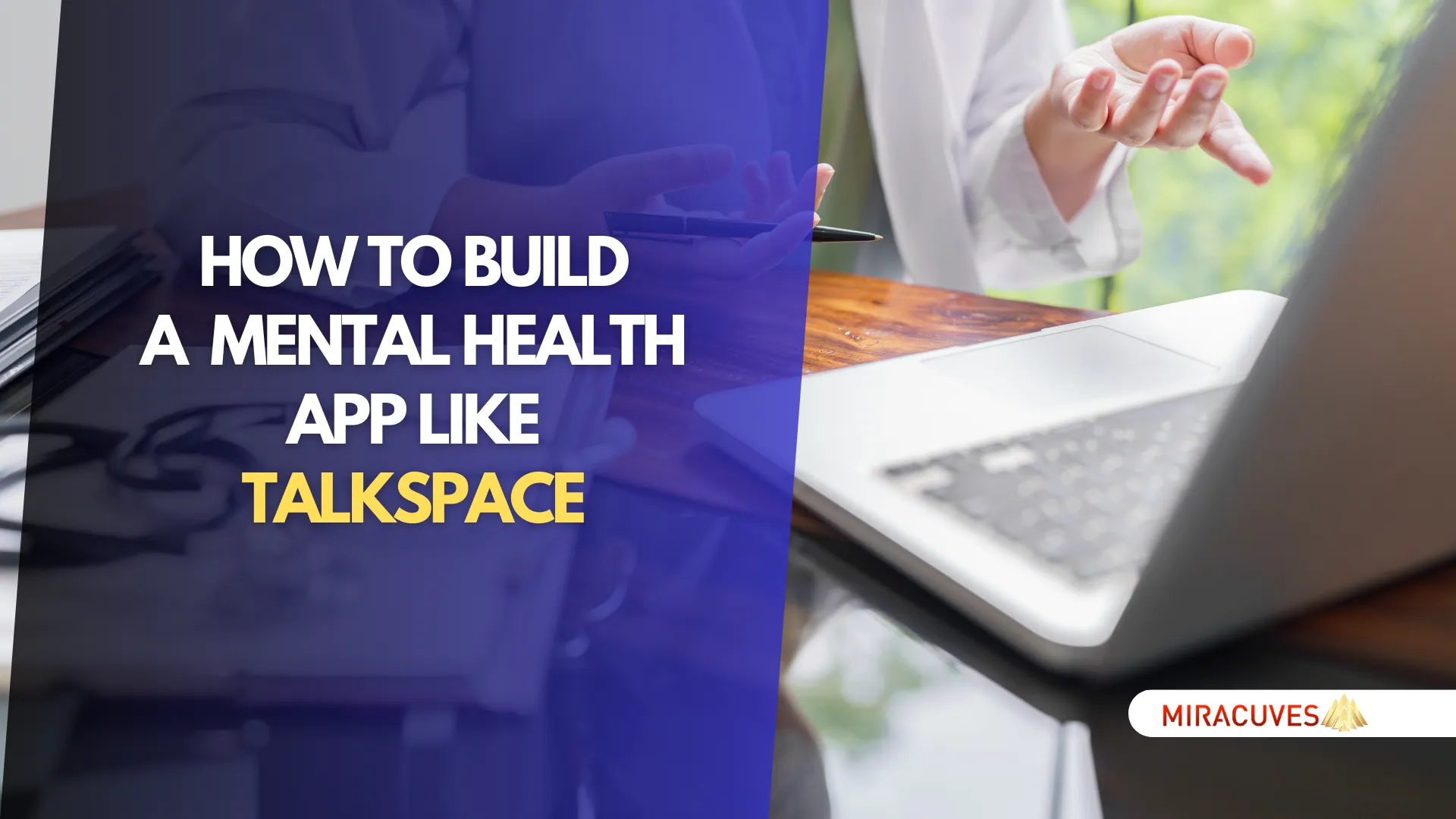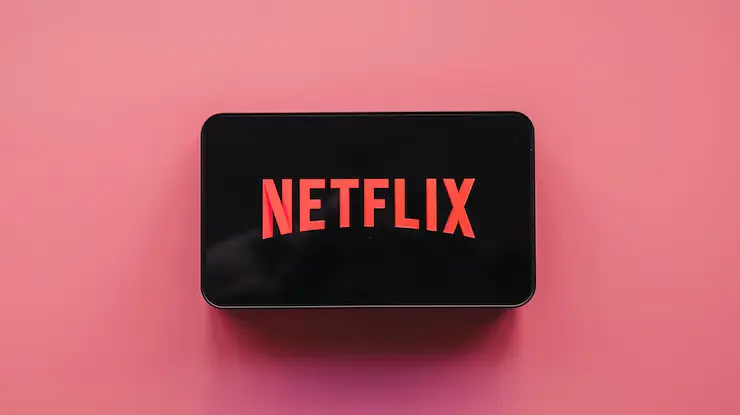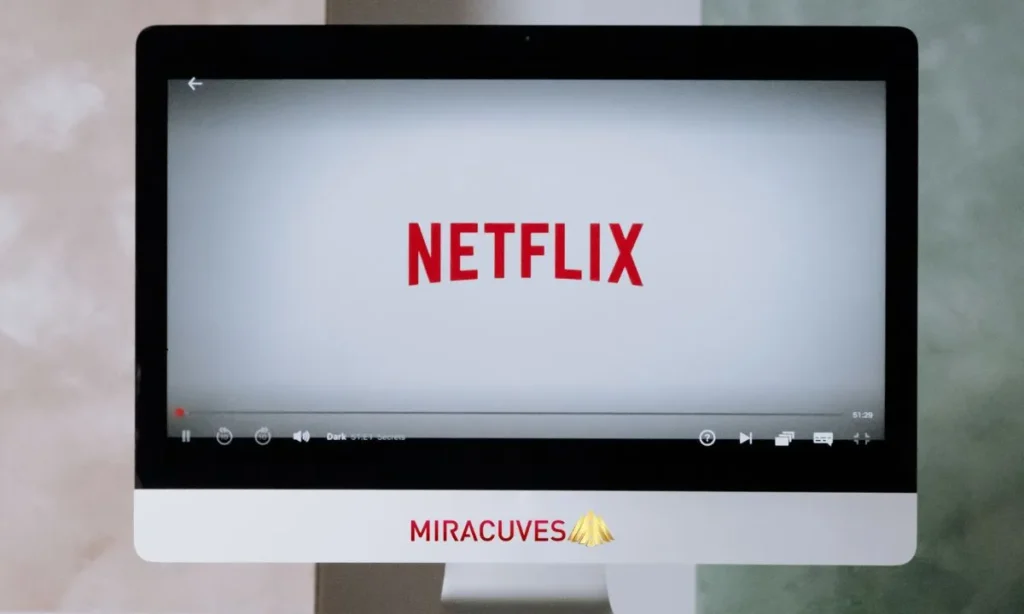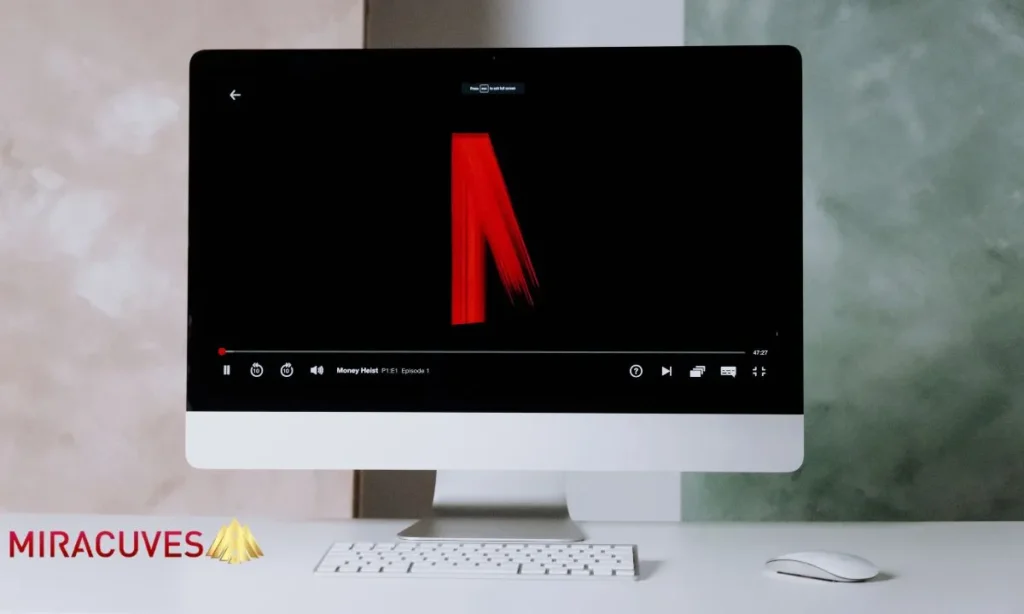In recent years, mental health awareness has surged, and the demand for accessible therapy has never been higher. With the advent of apps like Talkspace, millions of users have found a convenient, digital solution to seek professional counseling from the comfort of their homes. Talkspace has emerged as a leader in the online therapy space, connecting users to licensed therapists through text, video, and voice sessions.
Building an app like Talkspace offers immense potential to tap into this growing market, providing both social impact and profitable returns. In this guide, we’ll break down the essential features of a Talkspace-like app, the technical requirements, and the costs involved in development, helping you understand how to bring your own mental health app idea to life.
What is Talkspace and What Does It Do?
Talkspace is an online therapy platform designed to make mental health services accessible to everyone. Launched in 2012, the app connects users with licensed therapists via secure messaging, video, and audio sessions. It eliminates the need for in-person visits, allowing people to seek therapy from the comfort of their homes or while on the go. Users can choose from various subscription plans, giving them access to therapy on a schedule that fits their lives.
The key appeal of Talkspace lies in its convenience and flexibility. Users can message their therapist anytime, without the need to book appointments weeks in advance. This “anytime therapy” model has revolutionized mental health care, especially for people dealing with anxiety, depression, or stress who might find it challenging to attend regular in-person therapy sessions.
What sets Talkspace apart is its wide network of licensed professionals. Each therapist on the platform undergoes rigorous screening and verification, ensuring users receive quality care. Talkspace also offers specialized therapy, such as couples counseling and psychiatric services, including prescription management.
For developers looking to build an app like Talkspace, understanding its core functionalities—such as secure messaging, therapist-matching algorithms, and subscription-based pricing—is crucial. These features, combined with the app’s accessibility and mental health impact, make it a leading example in the online therapy market.
| Feature | Talkspace | BetterHelp | 7 Cups |
|---|---|---|---|
| Therapist Communication | Text, Audio, Video Sessions | Text, Audio, Video Sessions | Text-only (with option for group chats) |
| Therapist Matching | Algorithm-based Matching | User Selects Therapist | User Selects Therapist |
| Subscription Plans | Monthly Subscription, Tiered | Monthly Subscription, Tiered | Free for Peer Support, Paid for Therapy |
| Specialized Therapy | Couples Counseling, Psychiatry | Couples Counseling | Peer Support, Professional Therapy |
| Prescription Services | Available | Not Available | Not Available |
| Insurance Coverage | Yes, for Select Plans | No | No |
| HIPAA Compliance | Yes | Yes | Yes |
Why Build This App?
Building a mental health app like Talkspace is not just a profitable venture—it’s also a socially impactful one. The world is witnessing an unprecedented demand for mental health services, with more people turning to digital solutions for therapy and counseling. The COVID-19 pandemic further accelerated the shift toward telehealth, and online therapy platforms like Talkspace became a lifeline for individuals struggling with anxiety, depression, and other mental health issues.
By creating an app similar to Talkspace, you’re addressing a significant gap in the mental health industry. Many people, especially those in underserved areas, don’t have easy access to therapists. Online therapy apps provide a solution by offering convenience, flexibility, and affordability. Users no longer need to travel long distances or take time off work for in-person sessions—they can access therapy on their schedule, right from their devices.
From a business perspective, the mental health app market is projected to grow substantially. The global telehealth market is expected to reach over $380 billion by 2027, with mental health services playing a major role. This growth presents an opportunity for developers and entrepreneurs to tap into a fast-growing market while providing a service that truly helps people.
Moreover, when building your app, cost and development time are key factors to consider. This is where Miracuves Solutions comes in as a game-changer. By offering ready-made app solutions at 10% of the global cost, you can build an app for around $600 instead of $6000. What’s more, Miracuves Solutions can deliver a fully functioning app in just 10 days, compared to the typical industry standard of 1 month.
| Development Stage | Global Cost (Average) | Miracuves Solutions Cost |
|---|---|---|
| App Design | $1500 | $150 |
| Backend Development | $2000 | $200 |
| Frontend Development | $1000 | $100 |
| Testing and Quality Assurance | $500 | $50 |
| App Launch and Deployment | $1000 | $100 |
| Total Cost | $6000 | $600 |
How to Differentiate Your App from Others
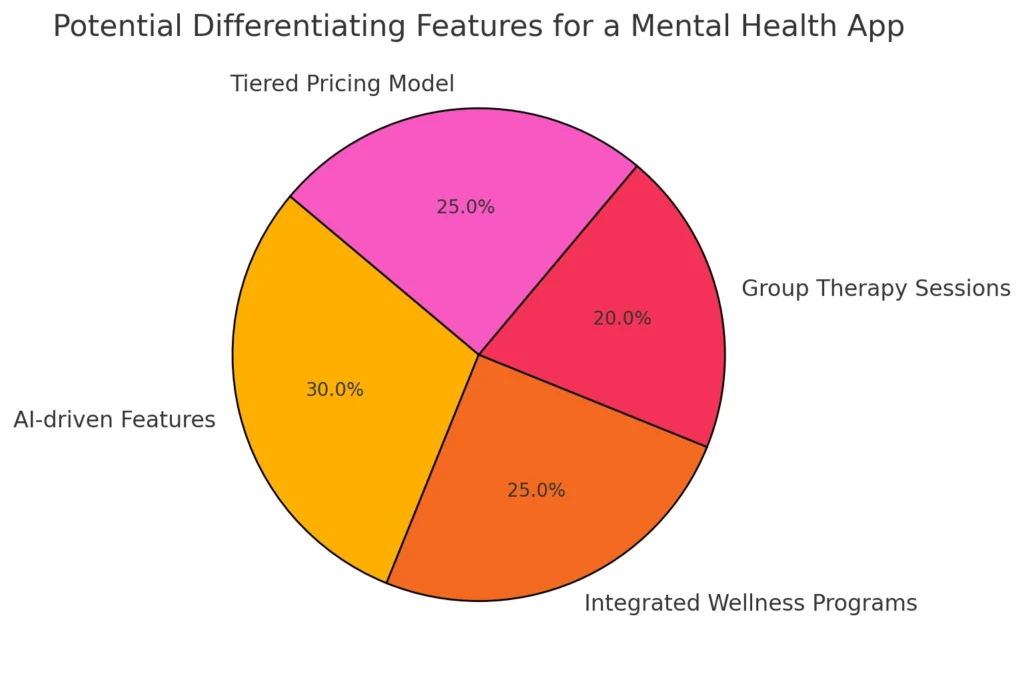
The mental health app market is competitive, with platforms like Talkspace, BetterHelp, and others vying for user attention. To succeed, it’s crucial to build an app that stands out from the crowd. Differentiation is key—users are looking for features that go beyond the standard therapy sessions. Your app must offer a unique value proposition to capture a significant market share.
One way to differentiate your app is by incorporating AI-driven features. For instance, AI-based chatbots can offer immediate, round-the-clock support to users, helping them with calming exercises or self-assessments when therapists are unavailable. These AI tools can also triage users, directing them to the right therapist or resources based on their responses, making the user experience smoother and more personalized.
Another feature that could set your app apart is integrated wellness programs. While Talkspace focuses primarily on therapy, your app could offer users a comprehensive mental wellness package, including mindfulness exercises, meditation guides, sleep tracking, and mood journals. By combining therapy with wellness, your app can appeal to a broader audience interested in improving their overall mental health.
Moreover, offering group therapy sessions can be a game-changer. Group therapy provides a sense of community and peer support, which is a crucial aspect of mental health recovery. Incorporating live group sessions or support circles within your app would create a platform for users to share experiences and connect with others going through similar challenges.
Additionally, consider creating a tiered pricing model that caters to different income levels. Many users find traditional therapy expensive, and offering budget-friendly plans or pay-per-session options could attract a more diverse user base. You could even introduce free trials or limited-time promotions to get users hooked on your app’s services.
Market Size, Growth, Revenue, and Business Model
| App Category | Market Size (2022) | Projected CAGR (2022-2030) |
|---|---|---|
| Mental Health Apps | $4.2 billion | 20% |
| Fitness and Wellness Apps | $13.2 billion | 17% |
| Nutrition and Diet Apps | $6.3 billion | 15% |
| Sleep Tracking Apps | $2.1 billion | 18% |
| Telehealth Services | $95 billion | 19% |
The market for mental health apps has experienced rapid growth in recent years, driven by increasing awareness of mental health issues and the growing acceptance of telehealth services. With millions of people seeking accessible mental health solutions, the demand for therapy apps like Talkspace has surged. According to recent data, the global mental health app market is expected to grow at a compound annual growth rate (CAGR) of 20% between 2022 and 2030, with the overall telehealth market projected to reach over $380 billion by 2027.
This growth presents an excellent opportunity for developers and entrepreneurs looking to tap into a booming sector. A mental health app like Talkspace can be built with a subscription-based revenue model, offering users monthly or annual plans for unlimited access to therapy sessions. Other revenue models include pay-per-session options or partnerships with employers and insurance companies, allowing companies to provide mental health services to their employees as part of wellness programs.
Insurance integration is another potential revenue driver. Apps like Talkspace have partnered with major health insurance providers, allowing users to access therapy services as part of their health plans. This can significantly expand the app’s user base while providing consistent revenue streams.
Additionally, offering premium features, such as access to specialized therapists or exclusive content (e.g., guided meditations, wellness courses), can further boost app monetization. These premium options can cater to users willing to pay more for enhanced services, creating a tiered revenue structure that maximizes earnings.
Features of a Talkspace-Like App
When building a mental health app like Talkspace, the features you include are critical to its success. Users expect a seamless, intuitive experience that makes therapy accessible and engaging. Here are the essential features that your app should have to provide real value to users:
1. Therapist Matching
One of the core functions of Talkspace is its ability to match users with the right therapist based on their needs and preferences. This can be done through an algorithm that considers factors like the user’s mental health concerns, preferred communication style, and therapist availability. A well-designed matching system improves user satisfaction and retention.
2. Secure Messaging
Talkspace offers users the flexibility to communicate with their therapists via text, audio, or video messaging. Your app must have secure messaging features, complying with data protection regulations like HIPAA to ensure the privacy of users’ sensitive information. Encryption and secure login are essential for building trust.
3. Video and Audio Sessions
Providing live video and audio sessions allows users to have a more personal connection with their therapist, similar to traditional therapy sessions. High-quality video streaming, minimal lag, and an intuitive scheduling system are important features to include in your app.
4. Subscription and Payment Plans
Offering tiered subscription plans or pay-per-session options ensures that the app caters to different financial needs. Users should be able to upgrade or downgrade their plans seamlessly through the app, and integrating multiple payment gateways will help to maximize convenience.
5. Progress Tracking and Journals
Encouraging users to track their mental health progress through features like mood tracking, daily journals, and session reviews can be incredibly valuable. These tools help users to reflect on their journey and stay committed to the process, ultimately improving retention.
Minimum Viable Product (MVP)
When launching your app, it’s wise to focus on developing a Minimum Viable Product (MVP). The MVP should include the essential features—therapist matching, secure messaging, and video/audio sessions—so that you can launch quickly, gather user feedback, and iterate on additional features over time. By starting with an MVP, you reduce the time and cost to launch, allowing you to test the market before investing in advanced features.
Technical Requirements
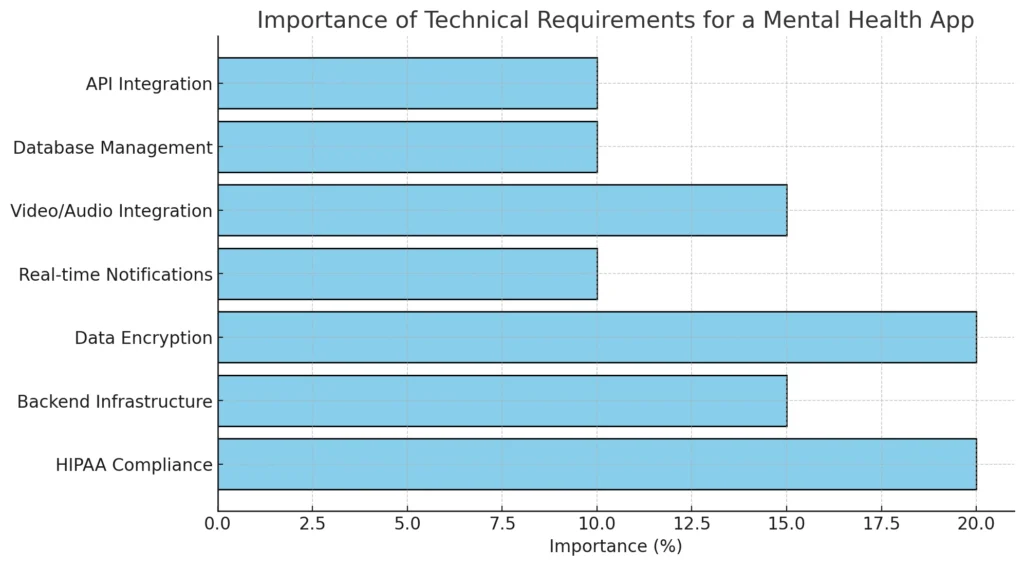
Building a mental health app like Talkspace requires not just user-friendly features but also a solid technical foundation to ensure smooth functionality, data security, and compliance with regulations. The technical requirements of the app are what will make or break the user experience, as well as the platform’s credibility in the mental health space.
1. HIPAA Compliance
One of the most critical aspects of developing a mental health app is ensuring compliance with the Health Insurance Portability and Accountability Act (HIPAA) in the U.S. or similar regulations in other regions. HIPAA protects sensitive patient data, and your app must have encryption protocols, secure user authentication, and data storage that adheres to these regulations.
2. Backend Infrastructure
Your app’s backend is responsible for handling user data, managing real-time communication, and ensuring smooth operation. A robust backend infrastructure should use cloud services like AWS or Google Cloud, offering scalability as the user base grows. APIs will be key in integrating features such as video conferencing, secure messaging, and payment processing.
3. Data Encryption
To ensure the privacy of communication between users and therapists, data encryption is non-negotiable. All messaging and video/audio communication should be end-to-end encrypted, preventing unauthorized access to sensitive information.
4. Real-time Notifications
A successful mental health app like Talkspace relies on timely notifications to keep users engaged. From reminders about therapy sessions to new message alerts, push notifications should be part of the app’s technical design, ensuring users stay on top of their mental health journey.
5. Video and Audio Integration
High-quality video and audio integration is essential for delivering therapy sessions that feel as close to in-person as possible. You’ll need to use WebRTC or similar technologies to ensure low latency, clear sound, and video quality, even with varying internet speeds.
6. Database Management
The app will need a secure and scalable database to store user information, session histories, and therapist data. Choosing the right database management system, like MySQL or PostgreSQL, ensures the app can handle large volumes of data efficiently and securely.
7. API Integration
To expand the functionality of your app, you’ll need to integrate third-party APIs for payment gateways (such as Stripe or PayPal), video conferencing tools, and possibly AI-powered chatbots for initial user assessments. These integrations enhance the overall user experience and streamline backend operations.
Design and User Interface (UI/UX)
When it comes to mental health apps, user experience is critical. The design and user interface (UI/UX) need to be intuitive, calming, and easy to navigate. Mental health users often experience stress, anxiety, or depression, so your app should create an environment that feels safe, supportive, and inviting.
1. Simple and Clean Interface
The user interface should be simple and free from clutter. When users are looking for help, they don’t want to struggle to find the right options. A minimalist design with clearly labeled menus, buttons, and navigation paths ensures that users can focus on what matters—accessing therapy services. Your app should feature easy onboarding, where users can quickly sign up or log in without unnecessary steps.
2. Calming Color Scheme
Colors play a big role in how users feel when interacting with your app. Opt for soft, calming colors like light blues, greens, and pastels to create a soothing atmosphere. Avoid harsh or overly vibrant colors that can overwhelm users.
3. User-friendly Navigation
Intuitive navigation is key to keeping users engaged. All features, such as messaging with therapists, scheduling appointments, or tracking mood, should be easily accessible. A tab-based navigation system can help users switch between functions quickly without getting lost in layers of menus.
4. Accessibility Features
Your app should prioritize accessibility to ensure it can be used by individuals with disabilities. This includes adding features like screen reader compatibility, larger font size options, and color-blind-friendly designs. Ensuring that your app is accessible to everyone will expand your potential user base and demonstrate your commitment to inclusivity.
5. Personalized User Experience
A personalized experience makes users feel more connected to the app. Allow users to customize their profiles, track progress through journals or mood logs, and receive tailored recommendations for mental health resources. Personalized notifications, such as session reminders or mindfulness tips, can further enhance engagement.
6. Responsive Design
Your app must be designed to work seamlessly across all devices, from smartphones to tablets. A responsive design ensures that the app looks and functions perfectly, no matter what device users are on. Given the high usage of mobile devices, making sure your app is mobile-friendly is essential.
A well-designed user interface can improve user retention, making your mental health app a go-to platform for therapy and well-being.
Development Process
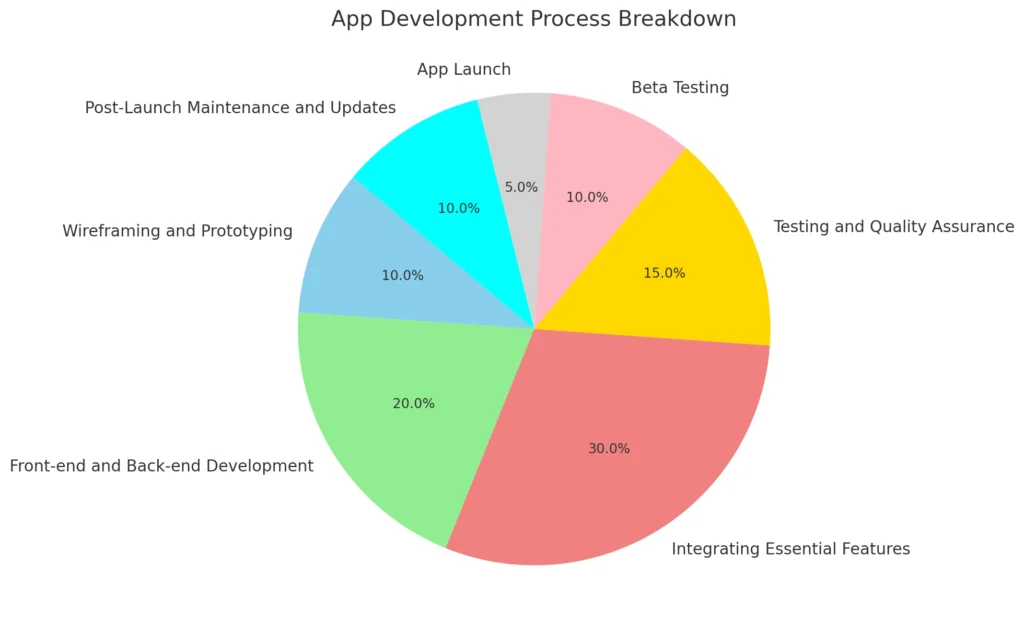
Creating an app like Talkspace involves a clear and organized development process. Each step ensures that the app runs smoothly, is user-friendly, and meets the technical requirements necessary for secure and effective mental health services. Here’s a breakdown of the key steps in the development process:
1. Wireframing and Prototyping
The first step in developing a mental health app is creating a wireframe, which is essentially a blueprint of the app’s structure. This allows developers and stakeholders to visualize the app’s layout, navigation flow, and key features. After wireframing, a prototype is developed. The prototype is a basic, interactive version of the app, allowing you to test the user interface and gather feedback before full development begins.
2. Front-end and Back-end Development
Once the wireframe and prototype are approved, the actual development work starts. The front-end development focuses on the user interface (UI)—what users see and interact with. This includes the design, animations, and responsive layout across devices. Meanwhile, the back-end development handles the server-side functionality, managing databases, secure user authentication, and communication between users and therapists.
3. Integrating Essential Features
During development, core features such as secure messaging, video/audio calls, and therapist-matching algorithms are integrated into the app. These features need to work seamlessly together to create a smooth user experience. API integrations are also added, such as payment gateways, real-time notifications, and video conferencing tools.
4. Testing and Quality Assurance
Before launching the app, thorough testing is crucial to ensure it works as intended. This includes functionality testing, performance testing, and security testing. Functionality testing ensures all features, such as secure messaging and scheduling, operate correctly. Performance testing checks the app’s speed and responsiveness under different conditions, such as heavy traffic. Security testing is done to verify that data encryption and user authentication are functioning properly, keeping users’ information safe.
5. Beta Testing
After internal testing, a beta version of the app is released to a small group of users. Beta testing allows real users to interact with the app and provide feedback on any issues, bugs, or improvements that might be needed. This step is invaluable for fine-tuning the app before a full public release.
6. App Launch
Once testing and final adjustments are complete, the app is ready for launch. At this stage, the app is submitted to platforms like the Apple App Store and Google Play Store, where it undergoes review for compliance with their policies. A successful launch relies on ensuring the app meets all technical requirements and guidelines for approval.
7. Post-Launch Maintenance and Updates
After the app goes live, continuous maintenance is essential. This includes monitoring performance, fixing bugs, and releasing updates to introduce new features or improve user experience. Regular updates based on user feedback help keep the app relevant and responsive to user needs.
Cost Estimation and Timeframe
| Development Stage | Global Cost (Average) | Miracuves Solutions Cost |
|---|---|---|
| App Design | $5,000 | $500 |
| Backend Development | $20,000 | $2,000 |
| Frontend Development | $10,000 | $1,000 |
| Testing and Quality Assurance | $5,000 | $500 |
| Launch and Deployment | $10,000 | $1,000 |
| Total Cost | $50,000 – $150,000 | $600 |
When developing a mental health app like Talkspace, cost and timeframe are two of the most critical factors to consider. Understanding the breakdown of costs and the typical development timeline can help you plan your budget and launch strategy effectively.
1. Global Cost Breakdown
The global cost for building a full-scale mental health app can range anywhere from $50,000 to $150,000, depending on the complexity of the app and the region where the development team is based. The majority of these costs come from the design, backend development, and integrating core features like secure messaging, video calls, and data encryption.
However, this cost can be significantly reduced by using Miracuves Solutions, which provides ready-made solutions for mental health apps at just 10% of the global cost. Instead of paying around $6000 for development, Miracuves Solutions offers the same high-quality app for as low as $600, cutting down development costs without sacrificing quality.
2. Timeframe Comparison
On a global scale, developing an app like Talkspace from scratch typically takes around 3 to 6 months, with various stages like prototyping, development, testing, and launch. However, Miracuves Solutions offers a significantly faster solution. With Miracuves, you can have your app ready in just 10 days, a fraction of the usual development time.
3. Factors Affecting Cost
The cost of app development can vary based on several factors:
- Features: Adding advanced features like AI-driven chatbots or group therapy sessions can increase costs.
- Design: Customizing the user interface or including animations may add to the budget.
- Compliance: Meeting regulations like HIPAA for data security requires additional development and testing, which can raise the price.
- Post-launch support: Maintenance, updates, and user feedback integration will require ongoing investment.
4. Miracuves Solutions’ Advantage
By choosing Miracuves Solutions, you’re not only saving money but also accelerating your time to market. A faster launch means you can start attracting users and generating revenue sooner, giving you a significant advantage over competitors who may be stuck in long development cycles.
Ready to start your own mental health platform like Talkspace?
We can help you design and develop a secure app with
integrated video calls, messaging, therapist matching, and payment solutions.
Monetization Strategies
A crucial aspect of building a successful mental health app like Talkspace is deciding how to monetize it. Monetization not only ensures the sustainability of your platform but also enables you to grow and expand your app’s features. Below are some of the most effective monetization strategies for a therapy app:
1. Subscription Model
The subscription model is the most common revenue stream for mental health apps. Users pay a monthly or yearly fee for unlimited access to therapy sessions, secure messaging, or video consultations. This model works well because it provides a steady, predictable income stream, allowing users to choose a plan that suits their budget and needs. Offering tiered subscriptions—such as basic, premium, and advanced—gives users the flexibility to pick features that match their therapy requirements.
2. Pay-per-Session
Another popular option is the pay-per-session model, where users pay for each therapy session individually. This model works particularly well for users who prefer a flexible, pay-as-you-go approach rather than committing to a subscription. It also allows therapists on the platform to offer specialized, one-off sessions for issues that might not require long-term care, such as stress management or workplace counseling.
3. Corporate Partnerships
Partnering with companies to provide mental health services for their employees is an excellent way to monetize the app. More businesses are recognizing the importance of mental health and wellness programs for their staff, and many are willing to invest in platforms like Talkspace to support their employees. You can offer bulk subscription plans to businesses or develop specialized packages tailored to corporate wellness programs.
4. Insurance Integration
Integrating insurance into your mental health app can provide a new avenue for revenue. If your app is covered by major insurance providers, users can access therapy services with minimal out-of-pocket expenses. This will not only make the app more accessible to a wider audience but also generate income through reimbursement from insurance companies.
5. In-App Purchases
In-app purchases offer another revenue stream by allowing users to buy additional services, such as mindfulness courses, guided meditations, or self-help resources. These purchases can be bundled as part of the therapy service or offered as a standalone product for users who are interested in boosting their mental well-being outside of therapy.
6. Advertising
While advertising may not be suitable for a mental health app focused on privacy, some platforms incorporate non-intrusive ads for wellness products or services that align with their audience’s needs. If done carefully, ads can provide a supplemental revenue stream without detracting from the user experience.
By implementing one or a combination of these strategies, you can ensure your mental health app generates consistent revenue while also offering value to users.
The telehealth market is expected to reach over $380 billion by 2027, with mental health services playing a major role.
Launching and Marketing the App
Launching a mental health app like Talkspace is an exciting milestone, but it’s just the beginning. To ensure its success, you need a well-planned marketing strategy that attracts users and keeps them engaged. A great app needs visibility, and the way you launch and market it can determine its long-term growth.
1. App Store Optimization (ASO)
App Store Optimization is essential for improving the visibility of your app in the Apple App Store and Google Play Store. Optimizing your app’s title, description, and keywords will help it rank higher in search results, making it easier for potential users to find. Using relevant keywords like “mental health app,” “therapy on demand,” or “online counseling” can attract users looking for solutions like Talkspace. Additionally, having compelling visuals—such as screenshots and demo videos—will increase download rates.
2. Content Marketing
Develop a content marketing strategy that educates your target audience about the benefits of your app. This could include writing blog posts, creating explainer videos, and publishing user testimonials that highlight the effectiveness of therapy through your platform. Sharing mental health tips and wellness advice through your app’s website and social media channels can build trust with potential users, encouraging them to try your app.
3. Influencer Marketing
Partnering with influencers who focus on mental health and wellness can help boost your app’s credibility and reach. Influencers can provide authentic recommendations to their followers, driving awareness and downloads. Look for therapists, life coaches, or mental health advocates who align with your brand’s mission.
4. Social Media Marketing
Using social media platforms like Instagram, Facebook, and LinkedIn to spread the word about your app is an excellent way to engage directly with potential users. Sharing content such as inspirational quotes, mental health resources, and success stories will help you build a community. You can also run paid social media ads targeting specific demographics, such as individuals dealing with anxiety, stress, or depression.
5. Email Marketing
Email marketing can be a powerful tool for onboarding new users and keeping existing ones engaged. Sending personalized email campaigns—such as introductory offers, wellness tips, and progress reminders—can enhance user retention. Use email to notify users about new features, promotions, or updates to keep them coming back to the app.
6. Partnerships with Healthcare Providers
Another effective marketing strategy is forming partnerships with healthcare providers, including therapists and mental health clinics. By offering your app as a tool for therapists to connect with their clients, you’ll increase your app’s user base and credibility. Additionally, collaborating with mental health organizations can help promote the app through their channels.
7. Launch Promotions
Consider running launch promotions such as offering a free trial period, discounted subscriptions, or exclusive content to new users. Promotions can create a sense of urgency and encourage potential users to try your app. Once they experience the benefits, they’re more likely to convert into long-term users.
By combining these strategies, your app will gain the visibility it needs to reach a wide audience and maintain long-term success.
Legal and Regulatory Considerations
When developing a mental health app like Talkspace, adhering to legal and regulatory requirements is crucial. These regulations not only protect users but also ensure that your app operates within the law. Understanding these considerations will help you build a credible and trustworthy platform.
1. HIPAA Compliance
In the United States, the Health Insurance Portability and Accountability Act (HIPAA) is vital for any app handling sensitive health information. HIPAA mandates the secure handling of personal health data, ensuring users’ privacy is maintained. Your app must implement robust security measures, such as encryption, secure data storage, and user authentication protocols. Failing to comply with HIPAA can result in hefty fines and loss of user trust.
In the United States, HIPAA compliance is vital for any app handling sensitive health information.
2. Data Privacy Regulations
Beyond HIPAA, various data privacy regulations may apply depending on where your users are located. For example, the General Data Protection Regulation (GDPR) in Europe requires that you collect user consent before processing their data. Make sure your app includes clear privacy policies, informing users about what data is collected, how it will be used, and their rights regarding their personal information.
3. Telehealth Regulations
Telehealth is subject to state and national regulations that dictate how mental health services can be delivered online. These laws can vary significantly, so it’s crucial to research the regulations in the regions where your app will operate. For instance, some states require therapists to be licensed in the state where the client is located. Ensuring compliance with these regulations is vital for legal operation.
4. Terms of Service and User Agreements
Your app should have clearly defined terms of service and user agreements that outline the rights and responsibilities of both the users and the platform. This legal document helps protect your app from liability and sets user expectations regarding the use of the service. Ensure that users acknowledge these terms upon registration.
5. Informed Consent
For mental health services, obtaining informed consent from users is essential. Users should fully understand what they are signing up for, including the nature of the therapy, potential risks, and benefits. Including an informed consent process within your app is not only a legal requirement but also fosters transparency and trust.
6. Record Keeping and Documentation
Maintaining accurate records of all user interactions, therapy sessions, and data handling practices is necessary for compliance with various regulations. Good record-keeping not only helps in audits but also enhances the overall quality of care provided through your app.
7. Insurance and Liability
Consider obtaining liability insurance to protect your business against potential lawsuits. As a mental health app, you may be held responsible for the services provided through your platform. Liability insurance can safeguard your business from financial loss due to claims related to user dissatisfaction or data breaches.
By paying close attention to these legal and regulatory considerations, you’ll build a solid foundation for your mental health app, ensuring it operates safely and effectively while fostering trust among users.
Future Growth of the App
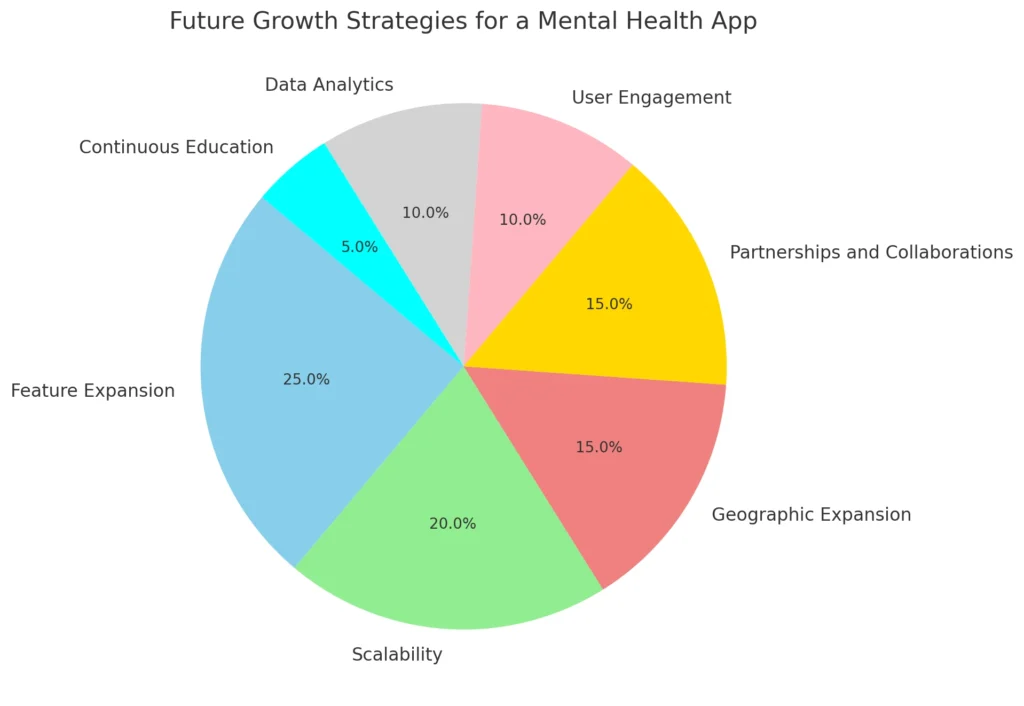
As the demand for mental health services continues to rise, the potential for growth in your mental health app like Talkspace is significant. To ensure that your app remains relevant and appealing to users over time, it’s essential to adopt strategies for future growth and adaptation. Here are several avenues to consider:
1. Feature Expansion
Continually enhancing your app with new features can attract and retain users. Regularly gather feedback from your users to understand what additional services they might want. This could include integrating AI-driven chatbots for immediate support, offering mindfulness and wellness programs, or expanding into specialized therapy types like trauma-informed care or addiction counseling.
2. Scalability
Design your app architecture to be scalable from the start. As your user base grows, your app should be able to handle increased traffic without compromising performance. Cloud services, such as AWS or Google Cloud, can provide the necessary infrastructure to accommodate this growth.
3. Geographic Expansion
Consider expanding your app’s reach by localizing content and services for different regions. This might involve translating the app into multiple languages or tailoring therapy options to reflect cultural sensitivities. By making your app accessible to a broader audience, you can tap into new markets and increase your user base significantly.
4. Partnerships and Collaborations
Forming partnerships with healthcare providers, educational institutions, or corporate wellness programs can enhance your app’s visibility and credibility. Collaborations can lead to mutually beneficial marketing efforts, such as joint webinars or health fairs, where you can promote your app directly to potential users.
5. User Engagement and Community Building
Creating a community within your app can enhance user engagement. Consider adding forums or discussion groups where users can share their experiences and support each other. This not only helps in retention but also fosters a sense of belonging among users, making them more likely to stick with your app over time.
6. Data Analytics
Utilize data analytics to monitor user behavior, preferences, and engagement metrics. Understanding how users interact with your app can provide insights into areas for improvement. Analytics can help you identify which features are most popular, enabling you to focus your development efforts effectively.
7. Continuous Education
As the mental health landscape evolves, keeping your content up to date is essential. Provide users with the latest research findings, mental health tips, and wellness strategies. Regularly updating educational content will position your app as a trusted resource in the mental health space.
By focusing on these growth strategies, your mental health app can adapt to changing user needs and market trends, ensuring its longevity and success in a rapidly evolving digital landscape.
Read More “Developing a Mental Health App Like BetterHelp: Costs, Features, and More“
Why Do You Trust Miracuves Solutions for Your Next Project?
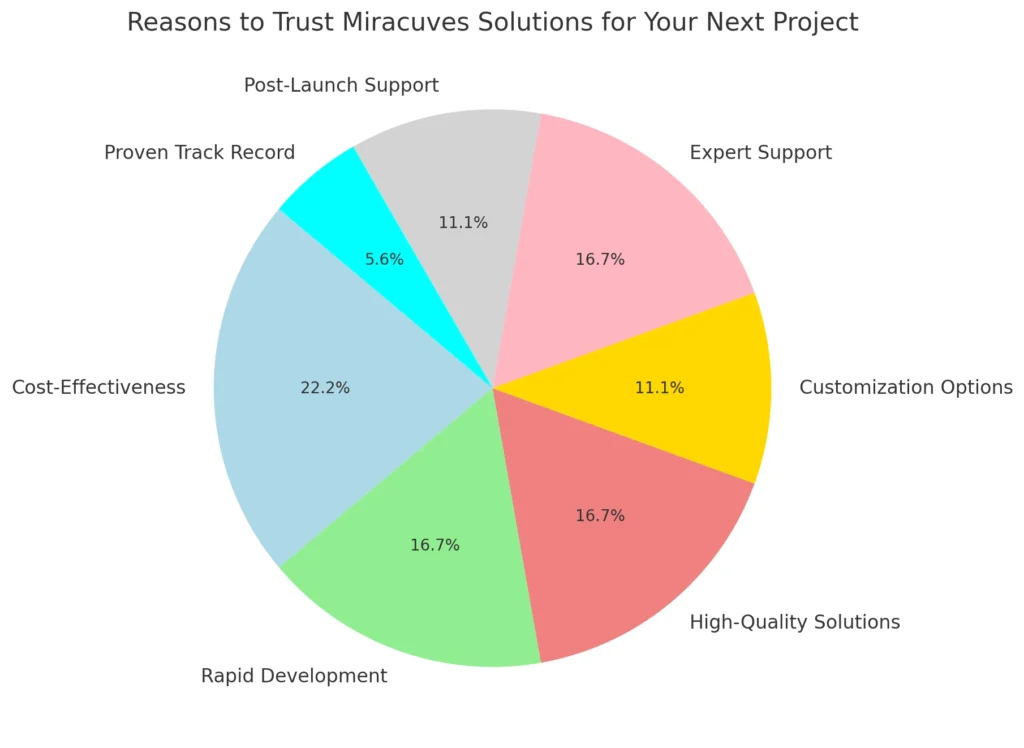
When it comes to building a mental health app like Talkspace, choosing the right development partner is crucial. Miracuves Solutions stands out as a reliable choice for several compelling reasons, ensuring that your app not only meets the highest standards but also achieves your business goals.
1. Cost-Effectiveness
One of the most significant advantages of working with Miracuves Solutions is the cost savings. By offering ready-made solutions at just 10% of the global cost, you can build a high-quality mental health app for as low as $600 instead of the typical $6000. This cost-effectiveness allows you to allocate resources to other critical areas, such as marketing and user engagement.
2. Rapid Development
Time is of the essence in the fast-paced tech world. Miracuves Solutions can deliver your app in just 10 days, compared to the industry standard of 1 month or more. This rapid turnaround means you can enter the market faster, start attracting users, and begin generating revenue sooner.
3. High-Quality Solutions
Despite the lower costs and quicker development times, Miracuves Solutions does not compromise on quality. Their ready-made apps are built using the latest technologies and best practices, ensuring that your platform is robust, secure, and user-friendly. Each app undergoes rigorous testing to meet industry standards.
4. Customization Options
While ready-made solutions are efficient, customization is key to standing out in a competitive market. Miracuves Solutions offers flexible customization options, allowing you to tailor features to meet your specific needs and user preferences. This ensures your app can adapt as your business grows and evolves.
5. Expert Support
Partnering with Miracuves Solutions means gaining access to a team of experienced professionals who understand the intricacies of app development and the mental health landscape. Their expertise can guide you through the development process, ensuring that you address key regulatory and compliance issues effectively.
6. Post-Launch Support
After your app is launched, Miracuves Solutions continues to provide support and maintenance services. This ensures that any issues are quickly resolved and that your app remains up to date with the latest features and security protocols. Ongoing support is crucial for keeping users engaged and satisfied.
7. Proven Track Record
Finally, Miracuves Solutions has a proven track record of delivering successful apps across various industries, including mental health. Their portfolio showcases a commitment to excellence and a deep understanding of user needs, making them a trustworthy partner for your project.
In conclusion, choosing Miracuves Solutions for your mental health app development means investing in a partnership that prioritizes quality, affordability, and speed. With their support, you can turn your vision into a reality while making a meaningful impact in the mental health space.
Conclusion
Building an app like Talkspace represents a powerful opportunity to make a meaningful impact in the mental health space while tapping into a rapidly growing market. As more individuals seek convenient, accessible therapy options, your app can provide essential support to those in need. Throughout this guide, we’ve explored the vital components necessary for developing a successful mental health app, including core features, technical requirements, legal considerations, and effective monetization strategies.
Choosing Miracuves Solutions as your development partner enhances your chances of success. With their cost-effective, ready-made solutions, you can launch your app quickly and affordably, allowing you to focus on creating an engaging user experience. Their commitment to quality and ongoing support ensures that your app remains relevant and competitive.
By prioritizing user needs and continuously adapting to market trends, you can build a platform that not only stands out in a crowded field but also genuinely helps users improve their mental well-being. The future of mental health services is digital, and with the right tools and strategies, your app can lead the way.
Take the first step toward transforming your mental health app vision into reality. Embrace the potential for growth, user engagement, and community building in this crucial area of health care. The journey may be challenging, but the rewards both for your business and the users you serve are immeasurable.
Interested in launching your own teletherapy platform?
Experience how we can integrate video chat, real-time messaging, and therapist connections into one seamless app.
FAQs
How much does it cost to build a mental health app with Miracuves Solutions?
Building a mental health app with Miracuves Solutions can cost as low as $600, significantly less than the average $6000 for traditional app development.
How quickly can I launch my app?
With Miracuves Solutions, you can have your app ready in just 10 days, allowing for a fast entry into the market compared to the usual 1 month or more.
What features should I include in my mental health app?
Essential features include secure messaging, therapist matching, video/audio sessions, progress tracking, and subscription/payment options to enhance user experience.
Is my app compliant with HIPAA regulations?
Yes, by working with Miracuves Solutions, you can ensure that your app is designed to meet HIPAA compliance standards, protecting user data and privacy.
How can I market my mental health app effectively?
You can market your app through app store optimization, content marketing, social media campaigns, influencer partnerships, and by forming collaborations with healthcare providers.
Support mental wellness with Miracuves – crafted for accessibility, trust, and meaningful connections:
Uber for Massage Like Platform – An on-demand wellness solution offering instant massage bookings, therapist profiles, and doorstep service convenience like platform.
Lybrate Like Platform– Seamless virtual therapy solutions inspired by Lybrate, enabling easy consultations, personalized care, and mental wellness support from anywhere.



